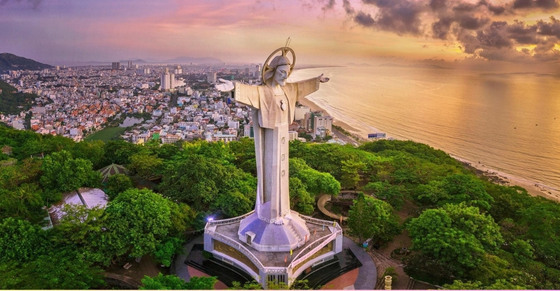Planning of megalopolis and conurbation in Vietnam until 2030
Below is the content of the planning of megalopolis and conurbation in Vietnam until 2030 according to Decision 891/QD-TTg.

Planning of megalopolis and conurbation in Vietnam until 2030 (Image from the internet)
On August 22, 2024, the Prime Minister of the Government of Vietnam issued Decision 891/QD-TTg approving the Planning of the Urban and Rural System for the period 2021 - 2030, with a vision to 2050.
Planning of megalopolis and conurbation in Vietnam until 2030
According to Decision 891/QD-TTg of 2024, the Planning of the Urban System until 2030 was announced, listing the special types, type I, type II, and type III urban areas in 06 regions nationwide.
In which, regarding the spatial organization orientations of the urban system, the planning has oriented the chains and clusters of urban areas in Vietnam until 2030 as follows:
Depending on the characteristics of natural conditions, developmental relationships, and resources, the urban chains and clusters are reasonably arranged in socio-economic regions, major urban areas; along border corridors, coastlines, islands and on the North - South, East - West economic corridors, creating reasonable linkages within each region and the entire national territory, integrating socio-economic development with ensuring security and defense:
Red River Delta Region: The Hanoi urban cluster with Hanoi Capital as the center (Hanoi metropolitan area); the northern coastal urban chain with Ha Long city and Hai Phong city as the centers (Northern Coastal Region);
Northern Midlands and Mountainous Region: The urban clusters and chains of Bac Giang, Thai Nguyen, Lang Son, Dong Dang, Bac Kan, Cao Bang, with Thai Nguyen, Bac Giang, and Lang Son cities as the centers (Northeast Mountainous Region); the urban clusters and chains of Lao Cai, Sa Pa, Yen Bai, Ha Giang, Tuyen Quang, Phu Tho, Viet Tri, with Viet Tri and Lao Cai cities as the centers (North Northwest Mountainous Region); the urban chain of Son La, Dien Bien, Lai Chau, Hoa Binh, with Hoa Binh and Dien Bien cities as the centers (Northwest Mountainous Region);
North Central and Coastal Central Region: The urban chain of Thanh Hoa, Sam Son, Nghi Son, Vinh (and Cua Lo), Hoang Mai, Hong Linh, and Ha Tinh, with Thanh Hoa city and Vinh city as the centers (North Central Region); the urban chain of Ba Don, Dong Hoi, Dong Ha, Quang Tri, Hue, and Chan May; Da Nang, Hoi An, Tam Ky, Quang Ngai, and Quy Nhon, with Thua Thien Hue city, Da Nang city, and Quy Nhon city as the centers (Central Central Region); the urban chain of Tuy Hoa, Van Phong, Nha Trang, Cam Ranh, Phan Rang Thap Cham, and Phan Thiet, with the urban cluster of Van Phong, Nha Trang, Cam Ranh (Khanh Hoa city) as the center (South Central Region);
Central Highlands Region: The urban chain of Kon Tum, Pleiku, Buon Ma Thuot, Gia Nghia connected with the national highway 14 corridor with Buon Ma Thuot city as the center; the urban cluster of Da Lat, Bao Loc, Di Linh with Da Lat city as the center;
Southeast Region: The urban cluster of Ho Chi Minh City with Ho Chi Minh City (Ho Chi Minh metropolitan area);
Mekong River Delta Region: The urban chain from Can Tho to Long An, with an orientation to accelerate urbanization and industrialization along the Western North - South expressway segment My An (Dong Thap) - Duc Hoa (Long An), the Eastern North - South expressway segment Can Tho - Ben Luc (Long An) and the area along the inland waterway transportation corridor Ho Chi Minh City - Can Tho; the urban chain along the Tien River - Hau River forming a counterbalance urban region with the Ho Chi Minh City region; developing the urban areas: Can Tho, Long Xuyen, Cao Lanh, Vinh Long into convergence points of development corridors along important transportation corridors of the region;
Along the North - South economic corridor: Forming urban clusters and chains along the economic corridor (i) the eastern region connected with North - South expressway and national highway 1A from Lang Son to Ca Mau and the western region, connected with Ho Chi Minh road and western North - South expressway; (ii) the dynamic areas with international airports and seaports, with potential science and technology, high-quality workforce; triangle Hanoi - Hai Phong - Quang Ninh, quadrilateral Ho Chi Minh City - Binh Duong - Dong Nai - Ba Ria Vung Tau, (iii) coastal area Da Nang - Thua Thien Hue - Quang Nam; and (iv) triangle Can Tho - An Giang - Kien Giang;
Along the East - West economic corridors: Forming urban clusters and chains connecting border gates and seaports, and regions of Vietnam with countries in the Mekong Subregion including: (i) Kunming - Lao Cai - Hanoi - Hai Phong Corridor; (ii) Moc Bai - Ho Chi Minh City - Bien Hoa - Vung Tau Corridor; (iii) Dien Bien - Son La - Hoa Binh - Hanoi Corridor; (iv) Cau Treo - Vung Ang Corridor; (v) Lao Bao - Dong Ha - Da Nang Corridor; (vi) Bo Y - Pleiku - Quy Nhon Corridor; Bo Y - Quang Nam - Da Nang Corridor; Buon Ma Thuot - Khanh Hoa Corridor; (vii) Chau Doc - Can Tho - Soc Trang Corridor; (viii) Ha Tien - Rach Gia - Ca Mau Corridor.
Urban Development Orientation in Vietnam until 2030
According to Decision 891/QD-TTg of 2024, regarding the development orientation of the urban and rural system, the urban and rural development targets for the period until 2030 are as follows:
- Urban system: The urbanization rate by 2030 will reach over 50%; by 2050 reach 70%; the number of urban areas nationwide will be around 1,000 - 1,200 urban areas; forming several national and regional-level urban centers that meet urban indicators of healthcare, education and training, urban culture equivalent to the average level of urban centers in the top 4 ASEAN countries; the urban economic area contributes approximately 85% to the national GDP; establishing a network of intelligent urban centers at the national and regional levels connecting internationally and 03 - 05 urban areas recognized with regional and international brands by 2030.
Urban population growth will average between 3.37 - 4.13% annually during the period 2025 - 2030; the ratio of urban construction land to total natural land area will reach approximately 1.9 - 2.3%, appropriate to the land use characteristics of each region.
- The ratio of transportation land to urban construction land will reach approximately 16 - 26%; the average green space area per urban resident will reach around 8 - 10 m²; the average floor area per capita in urban areas will reach a minimum of 32 m²; universal optical broadband Internet service, universal 5G mobile network service, the ratio of adult population in urban areas with electronic payment accounts over 80%; the ratio of urban population with access to clean water ensuring clean water quality reach 100%; the ratio of household wastewater treated in urban areas of type II and above will reach 40 - 45%. The ratio of urban domestic solid waste processed by direct landfill technology over the total amount of collected waste will be below 10%.
- Rural system: Nationwide, at least 90% of communes achieve new rural standards, of which 50% of communes achieve advanced new rural standards; striving to have approximately 70% of districts, district-level towns, provincial cities achieving new rural standards, completing the task of building new rural areas; among which 35% of districts achieving standards are recognized as advanced new rural districts, model new rural districts; striving for 100% of districts to have urban areas.
Striving for 100% of provincial administrative units to have sufficient 3 types of cultural facilities, including: Cultural or Cultural - Art Center, museum, library; 100% of district and commune administrative units to have Cultural - Sports Centers.
More details can be found in Decision 891/QD-TTg dated August 22, 2024.
- Key word:
- Vietnam
- in Vietnam
- Number of deputy directors of departments in Vietnam in accordance with Decree 45/2025/ND-CP
- Cases ineligible for pardon in Vietnam in 2025
- Decree 50/2025 amending Decree 151/2017 on the management of public assets in Vietnam
- Circular 07/2025 amending Circular 02/2022 on the Law on Environmental Protection in Vietnam
- Adjustment to the organizational structure of the Ministry of Health of Vietnam: Certain agencies are no longer listed in the organizational structure
- Vietnam aims to welcome 22-23 million international tourists in Vietnam in 2025
-

- Number of deputy directors of departments in Vietnam ...
- 15:04, 05/03/2025
-

- Cases ineligible for pardon in Vietnam in 2025
- 14:43, 05/03/2025
-

- Decree 50/2025 amending Decree 151/2017 on the ...
- 12:00, 05/03/2025
-

- Circular 07/2025 amending Circular 02/2022 on ...
- 11:30, 05/03/2025
-

- Adjustment to the organizational structure of ...
- 10:34, 05/03/2025
-

- Notable new policies of Vietnam effective as of ...
- 16:26, 11/04/2025
-
.Medium.png)
- Notable documents of Vietnam in the previous week ...
- 16:21, 11/04/2025
-
.Medium.png)
- Notable documents of Vietnam in the previous week ...
- 16:11, 02/04/2025
-
.Medium.png)
- Notable new policies of Vietnam to be effective ...
- 16:04, 02/04/2025
-
.Medium.png)
- Notable new policies of Vietnam effective from ...
- 14:51, 21/03/2025

 Article table of contents
Article table of contents
